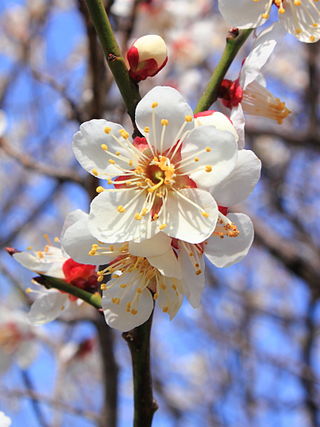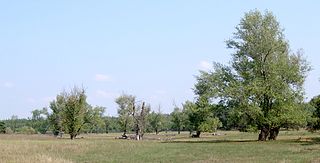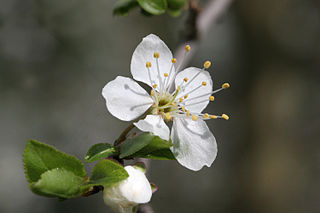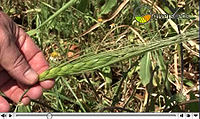
A plum is a fruit of some species in Prunus subg. Prunus. Dried plums are often called prunes, though in the United States they may be labeled as 'dried plums', especially during the 21st century.

A prune is a dried plum, most commonly from the European plum tree. Not all plum species or varieties can be dried into prunes. A prune is the firm-fleshed fruit (plum) of Prunus domestica varieties that have a high soluble solids content, and do not ferment during drying. Use of the term "prune" for fresh plums is obsolete except when applied to varieties of plum grown for drying.

Prunus is a genus of trees and shrubs in the flowering plant family Rosaceae that includes plums, cherries, peaches, nectarines, apricots, and almonds. The genus has a cosmopolitan distribution, being native to the North American temperate regions, the neotropics of South America, and temperate and tropical regions of Eurasia and Africa, There are about 340 accepted species as of March 2024. Many members of the genus are widely cultivated for their fruit and for decorative purposes. Prunus fruit are drupes, or stone fruits. The fleshy mesocarp surrounding the endocarp is edible while the endocarp itself forms a hard, inedible shell called the pyrena. This shell encloses the seed, which is edible in some species, but poisonous in many others. Besides being eaten off the hand, most Prunus fruit are also commonly used in processing, such as jam production, canning, drying, and the seeds for roasting.

Prunus cerasus is a species of Prunus in the subgenus Cerasus (cherries), native to much of Europe, North Africa and West Asia. It is closely related to the sweet cherry, but has a fruit that is more acidic. Its sour pulp is edible.

Prunus mume is a Chinese tree species classified in the Armeniaca section of the genus Prunus subgenus Prunus. Its common names include Chinese plum,Japanese plum, and Japanese apricot. The flower, long a beloved subject in the traditional painting and poetry of Sinospheric countries, is usually called plum blossom. This distinct tree species is related to both the plum and apricot trees. Although generally referred to as a plum in English, it is more closely related to the apricot. In East Asian cuisine, the fruit of the tree is used in juices, as a flavouring for alcohol, as a pickle, and in sauces. It is also used in traditional medicine.

Prunus armeniaca is the most commonly cultivated apricot species. The native range is somewhat uncertain due to its extensive prehistoric cultivation. Genetic studies indicate Central Asia is the center of origin. It is extensively cultivated in many countries and has escaped into the wild in many places.

Populus nigra, the black poplar, is a species of cottonwood poplar, the type species of section Aigeiros of the genus Populus, native to Europe, southwest and central Asia, and northwest Africa.

The damson or damson plum, also archaically called the "damascene", is an edible drupaceous fruit, a subspecies of the plum tree. Varieties of insititia are found across Europe, but the name damson is derived from and most commonly applied to forms that are native to Great Britain. Damsons are relatively small ovoid plum-like fruit with a distinctive, somewhat astringent taste, and are widely used for culinary purposes, particularly in fruit preserves and jams.

Prunus cerasifera is a species of plum known by the common names cherry plum and myrobalan plum. It is native to Southeast Europe and Western Asia, and is naturalised in the British Isles and scattered locations in North America. Also naturalized in parts of SE Australia where it is considered to be a mildly invasive weed of bushland near urban centers. P. cerasifera is believed to one of the parents of the cultivated plum, Prunus domestica perhaps crossing with the sloe, Prunus spinosa, or perhaps the sole parent. This would make it a parent of most of the commercial varieties of plum in the UK and mainland Europe - Victoria, greengages, bullace etc.

Mirabelle plum is a cultivar group of plum trees of the genus Prunus. It is believed that the plum was cultivated from a wild fruit grown in Anatolia.

Prunus serrulata or Japanese cherry is a species of cherry tree that grows naturally in Japan, China, Korea, and Vietnam, and it also refers to a cultivar produced from Prunus speciosa, a cherry tree endemic in Japan. Historically, the Japanese have developed many cultivars by selective breeding of cherry trees, which are produced by the complicated crossing of several wild species, and they are used for ornamental purposes all over the world. Of these, the cultivars produced by complex interspecific hybrids based on the Oshima cherry are also known as the Cerasus Sato-zakura Group.

Prunus salicina, commonly called the Japanese plum or Chinese plum, is a small deciduous tree native to China, Taiwan and Southeast Asia. It is an introduced species in Korea, Japan, Israel, the United States, and Australia.

The bullace is a variety of plum. It bears edible fruit similar to those of the damson, and like the damson is considered to be a strain of the insititia subspecies of Prunus domestica. Although the term has regionally been applied to several different kinds of "wild plum" found in the United Kingdom, it is usually taken to refer to varieties with a spherical shape, as opposed to the oval damsons.

Prunus maritima, the beach plum, is a species of plum native to the East Coast of the United States. It is a choice wild edible and its few pests and salt tolerance make it a resilient fruit crop for degraded lands and urban soils.

Prunus tomentosa is a species of Prunus native to northern and western China, Korea, Mongolia, and possibly northern India. Common names for Prunus tomentosa include Nanjing cherry, Korean cherry, Manchu cherry, downy cherry, Shanghai cherry, Ando cherry, mountain cherry, Chinese bush cherry, and Chinese dwarf cherry.

A crop wild relative (CWR) is a wild plant closely related to a domesticated plant. It may be a wild ancestor of the domesticated (cultivated) plant or another closely related taxon.

Prunus domestica is a species of flowering plant in the family Rosaceae. A deciduous tree, it includes many varieties of the fruit trees known as plums in English, though not all plums belong to this species. The greengages and damsons also belong to subspecies of P. domestica.

The perdrigon, occasionally spelt "perdigon", is an old variety of culinary plum originating in the south of France. It is sometimes classified as a variety of Prunus domestica subsp. insititia, like the British damson and German krieche, though it has significant differences from both. It was once classed as Prunus pertigona or Prunus domestica pertigona.

The prune plum is a fruit-bearing tree, or its fruit. It is a subspecies of the plum Prunus domestica. The freestone fruit is similar to, but distinct from, the clingstone damson and is especially popular in Central Europe.

Laxton Brothers was a business founded by Edward Augustine Lowe Laxton MBE (1869–1951) and William Hudson Lowe Laxton (1866–1923) who were notable horticulturists, pioneers of plant breeding and experts on fruit production creating several new strains of fruit such as 'Laxtonberry', 'Laxton's Delicious' plum tree, Laxton's No.1 red currant, Laxton’s Superb apples and the award-winning Lord Lambourne apple.






















